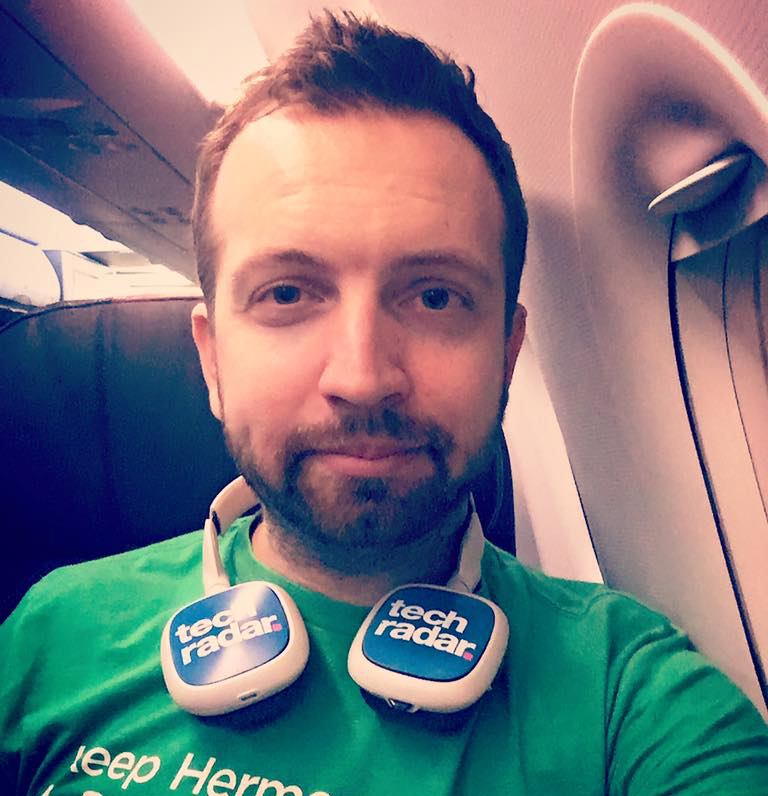Samsung Galaxy Fold review (original) (raw)
TechRadar Verdict
The Galaxy Fold delivers a ‘wow’ factor that no other phone offers today, and yet we’d only recommend it to early adopters with a penchant for impressing their peers, and who have money to burn. It’s a technical marvel, with technical limitations, and it makes us hopeful for a more fully rounded sequel.
Pros
- Supremely cool form factor
- Gaming taken to the next level
- Samsung's biggest battery
Cons
- -
Outrageously expensive - -
Vulnerable plastic screen
Why you can trust TechRadar We spend hours testing every product or service we review, so you can be sure you’re buying the best. Find out more about how we test.
Two-minute review
The Samsung Galaxy Fold is the most forward-thinking smartphone of 2019, finally delivering on the promise of a foldable phone, and instantly proving a real head-turner out on the streets. And yet, it's still not something we can recommend to most people.
Wherever we went with the Fold, people wanted to know what this thing was and how it worked. We demonstrated how it folds down to a 4.6-inch outer screen, and folds out out to become a 7.3-inch mini-tablet display – and it always amazed.
But then the second wow-factor kicks: it's twice the price of today's best smartphones, and on top of that it has a troubled track record with regard to durability, which could prove a deal-breaker for many potential buyers.
Samsung refined the Galaxy Fold over the course of a five-month delay to its launch, reinforcing the points where it broke in the hands of early reviewers. But we're still in constant fear of pixel tearing, or damaging the vulnerable plastic screen.
Good news: right now the bendable screen of our Galaxy Fold review unit is as pristine as the day we unboxed. It comes with a crease down the middle, but this is only really visible when it catches glare (or you purposefully look for it). A bigger deal is the uneven refresh rate across the larger display: as you scroll pages, one side lags ever so slightly behind the other – it's barely perceptible, but you can't unsee it once you realize it's there.
The Galaxy Fold is the best example of why foldable is the future of smartphones. Its 7.3-inch screen is built for productivity. We multi-tasked with three apps open on a phone, as if this were a tablet. Editing photos is easier, gaming takes a gigantic leap, and showing someone a complicated spreadsheet is doable.
Its folded size is satisfying for one reason: we loved carrying a small phone again. It'll go unappreciated in photos, and the extensive bezel around the 4.6-inch screen makes it feel cramped; but hold this tall, chunky, yet narrow phone in your hand and you'll swear glass phones aren't slippery after all. We felt confident one-handing it on busy streets.
The Galaxy Fold inherits the power and cameras of the Galaxy S10 Plus, which is nice, but we missed some photo and video modes offered by the Note 10 Plus – that five-month delay means Samsung’s latest and most cutting-edge phone isn’t actually its most capable camera-wise. You also won't find an S Pen stylus tucked inside (which it wouldn't be wise to use on a plastic screen anyway, but still).
Battery life was the toughest to judge. At 4,380mAh, the battery here is Samsung's biggest, and lasted us a day-and-a-half. But battery life varied wildly based on how long we had that big screen open – we killed it in less than a day when we tried.
The Samsung Galaxy Fold feels like the biggest sensation since the original iPhone – and, really, that's the only reason to take a $2,000 / £1,900 risk on it. This phone is strictly for early adopters with money to burn and a penchant for impressing, and it'll end up in a drawer with Google Glass and other gadgets ahead of their time.
Everyone else should wait for something cheaper, better, and more durable in a few months.
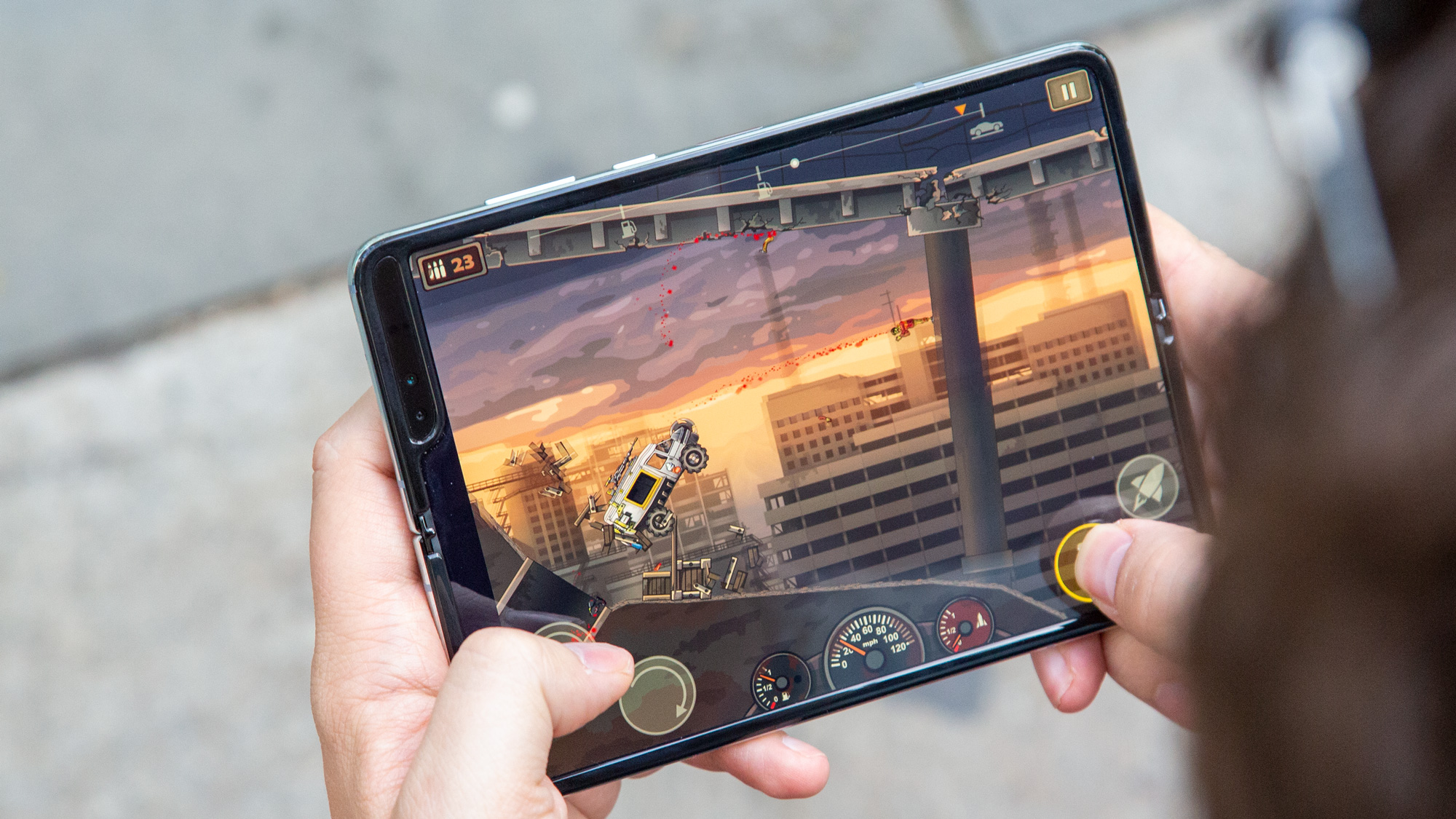
(Image credit: Future)
Samsung Galaxy Fold release date and price
- Double the price of flagship phones: 1,980/£1,900/AU1,980 / £1,900 / AU1,980/£1,900/AU2,900
- Launched in September in the US, UK and South Korea
- It was originally set to debut on April 26, 2019
- Two colors: Cosmos Black or Space Silver (Martian Green and Astro Blue have been axed)
The Samsung Galaxy Fold release date was staggered throughout the end of 2019, and getting your hands on it wasn't easy. It first came out in South Korea on September 6, and made its UK debut on September 18, when it sold out immediately.
The Galaxy Fold US release date was September 27, which was five months and one day after its original April 26 launch date. During this hiatus, Samsung tweaked the hardware, but the price remained the same: very high. Those in Australia were also able to buy the phone at the end of October 2019.
Stock of the Galaxy Fold has since stabilized in the markets where it's available, so if you are considering picking it you shouldn't have any trouble locating a unit.
The Samsung Galaxy Fold price is 1,980/£1,900/AU1,980 / £1,900 / AU1,980/£1,900/AU2,999, twice the cost of an iPhone 11 Pro. You can buy it through Samsung, local stores like Best Buy, or exclusive carrier partners: EE in the UK (from £109 per month for 24 months) and AT&T in the US (it's $66 a month for 30 months).
One important point to note: the UK has the 5G version of the Galaxy Fold, while the US Galaxy Fold is limited to 4G LTE.
Samsung packs in a pair of its black Samsung Galaxy Buds and a thin Kevlar case (it's unlikely to protect the Fold any further than preventing a few scratches on the glass), giving you a bit more for your money, and offers a Galaxy Premier Service 24/7 dedicated support service by phone, video chat, or in-person visit for the lifetime of the device. Then there's a one-year limited warranty, and a one-time $150 screen replacement fee if a wrecked display is your fault.
The price is our biggest hangup. It's hard to justify such an exorbitant price for a device that, while supremely cool, clearly isn't time-tested and feels awfully vulnerable. It's very much a first-generation device with a price tag to match.
We're also kind of disappointed that Cosmos Black and Space Silver are the only two colors – gone are more eye-catching Martian Green and Astro Blue, the two other options from the initial launch lineup.
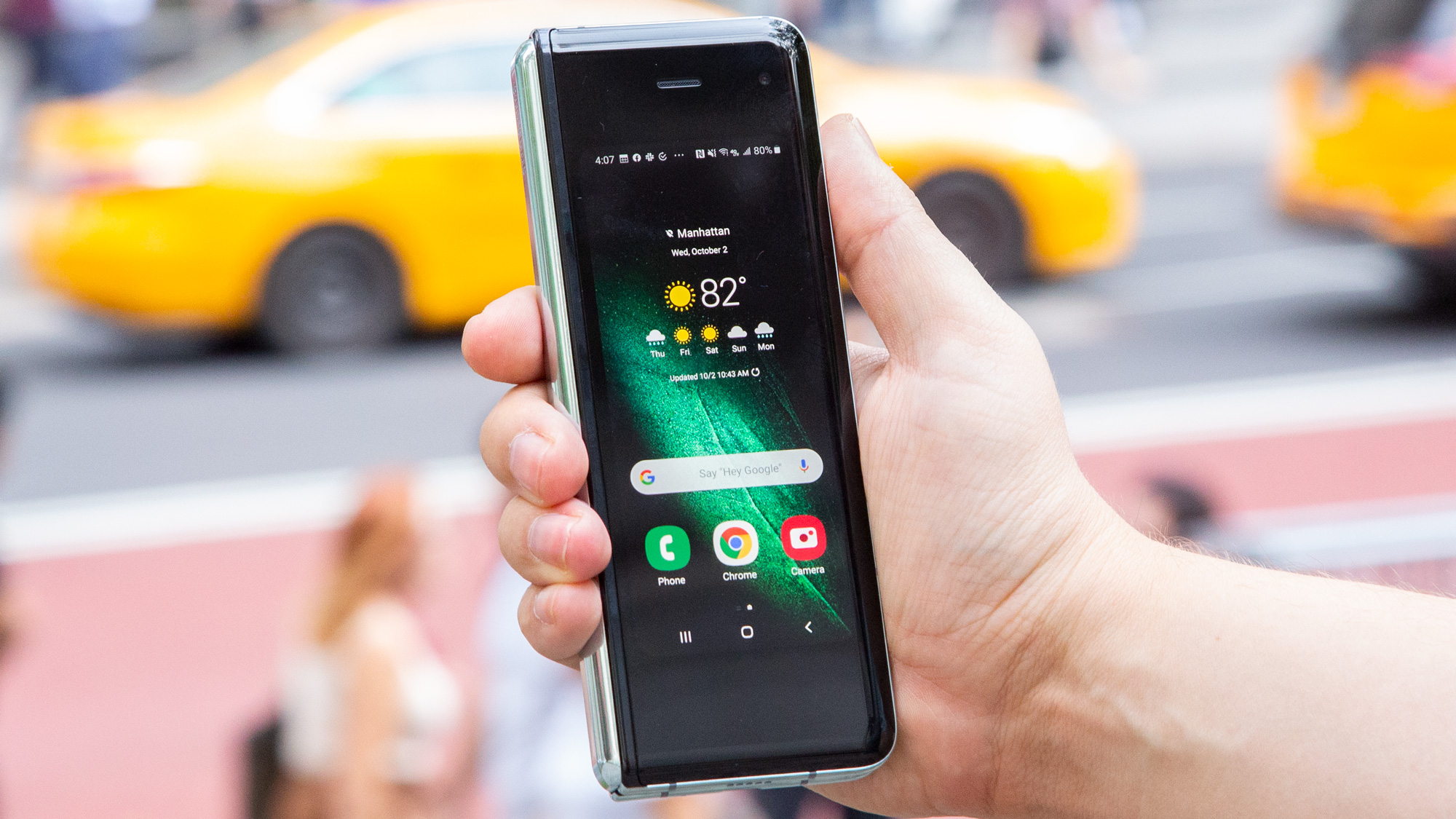
(Image credit: Future)
Foldable design and durability
Galaxy Fold specs
Weight: 276g
Folded: 62.8 x 160.9 x 17.1mm
Unfolded: 117.9 x 160.9 x 7.6mm
OS: Android 9
Main screen size: 7.3-inch
Resolution: QXGA+ (2152 x 1536)
Cover screen size: 4.6-inch
Resolution: HD+ (1680 x 720)
CPU: Octa-core
RAM: 12GB
Storage: 512GB
Battery (4G): 4,380mAh
Battery (5G): 4,235mAh
Cover camera: 10MP
Front camera: 10MP + 8MP
Rear camera: 16MP + 12MP + 12MP
The arrival of the Samsung Galaxy Fold gives you the opportunity to own the future of smartphones and tablets, with a 2-in-1 design that just makes sense – if the bendable screen technology holds up.
It marries a tall, narrow 4.6-inch 'cover' display behind glass on the outside with the foldable, mini-tablet-like 7.3-inch 'main' display behind plastic on the inside. Samsung calls this the Infinity Flex Display, and its design really does dazzle.
The key to the Galaxy Fold's book-like foldable design is a 20-part, dual-axis locking hinge that prevents the display from overextending past 180 degrees. Whereas the screen is delicate, the hinge feels like it's been meticulously engineered to withstand abuse.
Opening and closing the Fold feels buttery smooth, and closing it ends with a satisfying magnetic click, like you've just closed up a book. Remember what it was like to hang up on people with a flip phone or even an old telephone? That feeling is back – only now, you'll probably swallow them up in a video call.
Also coming back is smartphone heft. In its folded state, the Galaxy Fold is 17.1mm thick and weighs 276g; for comparison, the big-and-heavy Note 10 Plus is just 7.9mm and 196g.
However, it's narrower than you might think, and despite its thickness it isn't too hard to slip into a jeans pocket (although those with slim-fit pants will likely struggle) – it'll even fit into tight-yet-deep jacket pockets that other phones can't fit into, although there's no escaping the fact that it'll look like you're packing two phones back-to-back.
It is ungainly in aesthetic, and it feels awkwardly weighted in its folded state. It's not exactly what many would call pretty, and its size and weight will likely put a number of people off - the look and weight tended to be the first comments from those we passed the Fold to.
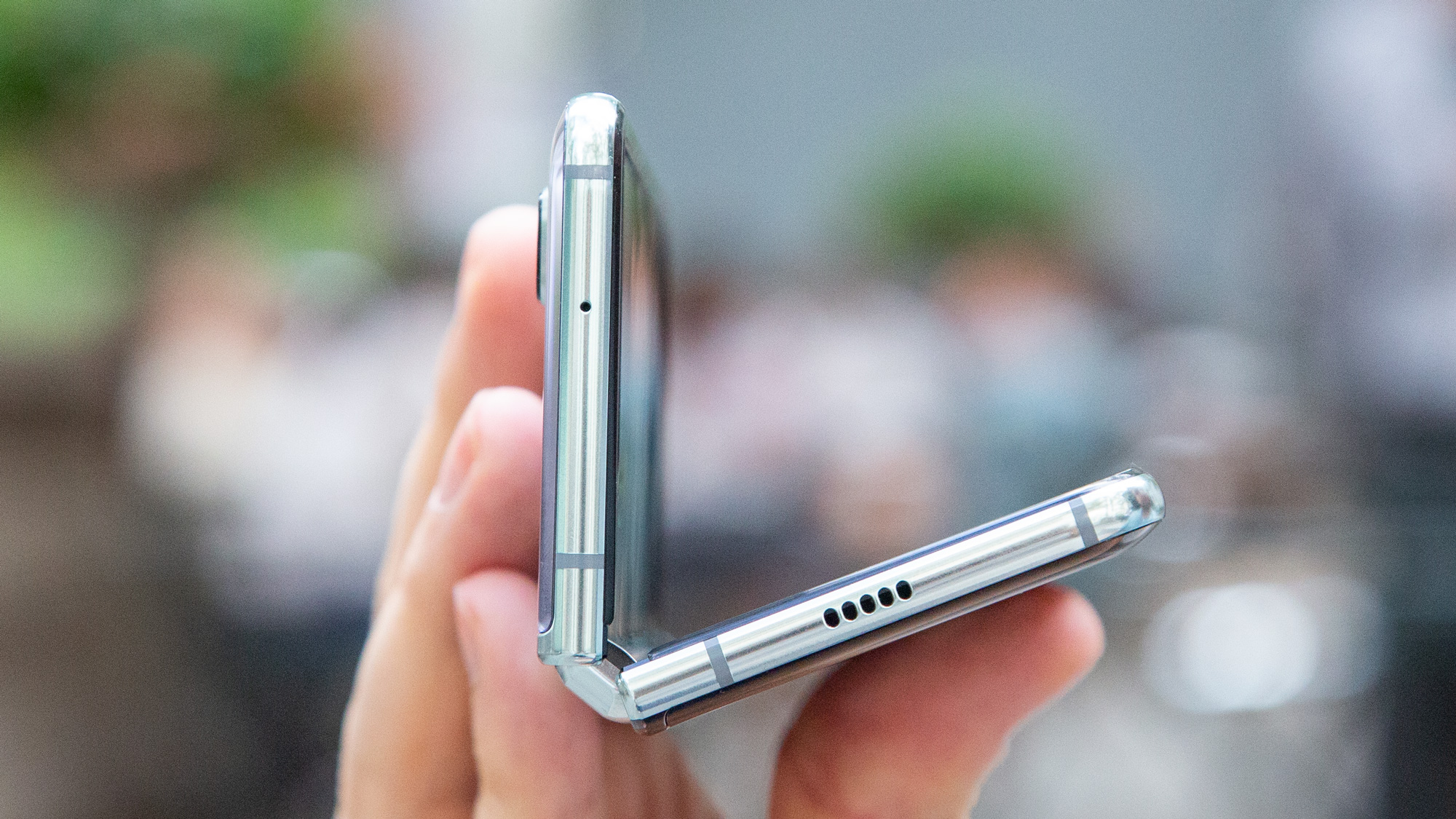
(Image credit: Future)
Unfolded, it's a much more reasonable 7.6mm thick. You'll find a fingerprint sensor, power/Bixby key, and volume rocker on the right (all accessible when the Fold is open or closed), although we found its placement a little tricky to reliably locate every time.
The indentation for the fingerprint scanner isn't pronounced enough, and it demands you complete cover the area with your digit in order to read your finger print. It saw us move away from using the scanner and instead lean on passcode and face unlock options.
There are two speakers, one at the top and one at the bottom, and it's easy to cover up these powerful Dolby Atmos stereo speakers when you're playing games or watching videos in landscape orientation. Pro tip: instead of uncomfortably choking up your grip, try rotating the Fold 180 degrees – most apps will rotate just fine.
When it's closed, an all-glass design envelopes the phone's outside. The glass is slippery, but we found its folded size so easy to grasp that we didn't feel the need to use the two-piece case that came in the box.
This ease of handling is one of the things that struck us the most in our testing – while everything else about the Fold has a futuristic vibe, its narrow size took us back to a time when phones were easy to hold in one hand.
If you love big screens, but are tired of juggling big phones, this is the biggest phone we've tested... and smallest (recent phone) at the same time. It's an idea that's been more than 10 years in the making and, as Samsung likes to say, went through 1,000 different prototypes. It's not a bad start, but there's surely more innovation to come.
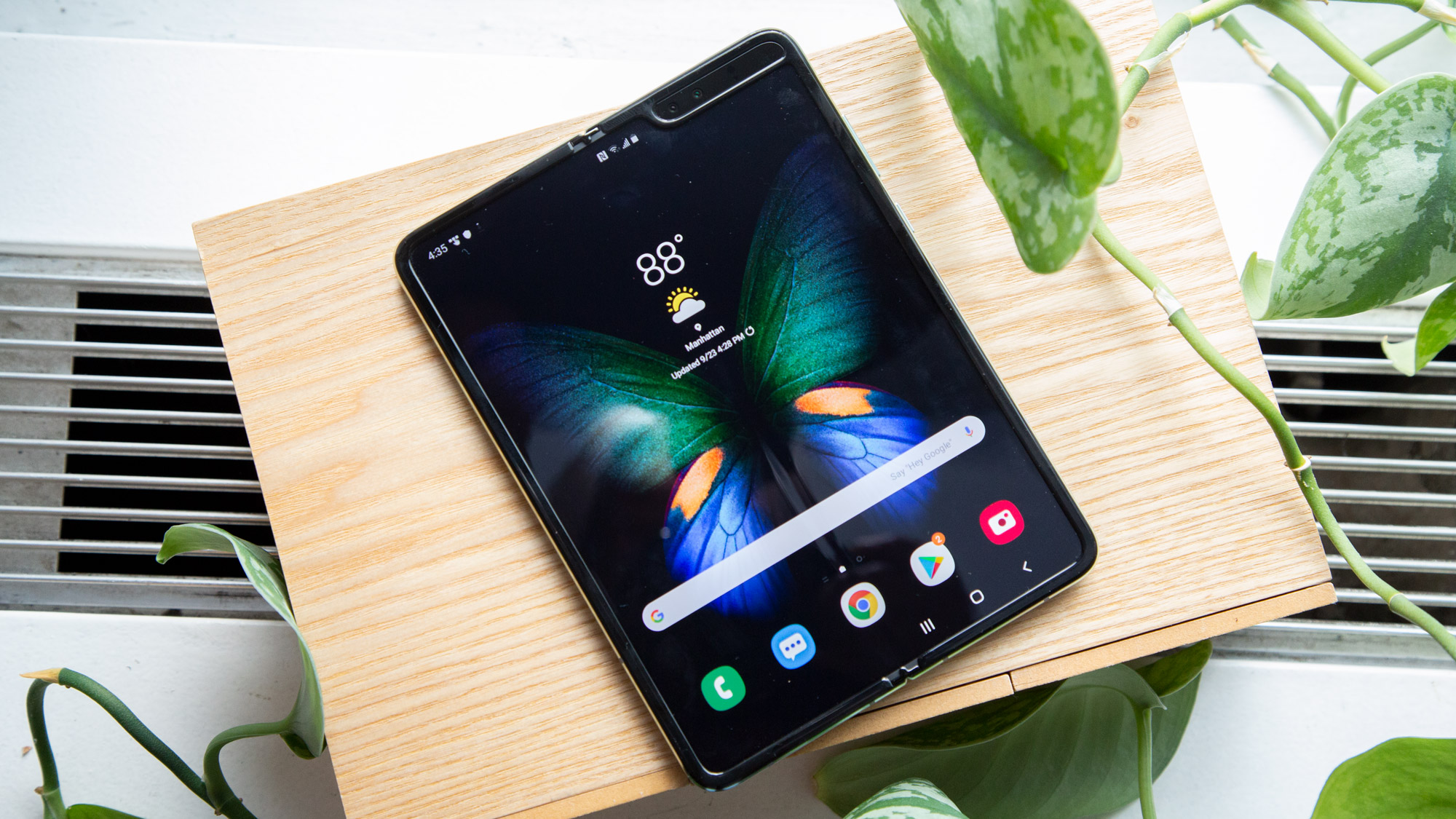
(Image credit: Future)
Screen
- 7.3-inch main display inside and 4.6-inch cover display outside
- Reading, browsing and gaming look great in 4.2:3 aspect ratio
- Most movies have letterboxing in 16:9 aspect ratio
- Great: HDR10+ and brightness; not great: middle crease and uneven refresh rate
Beyond the mesmerizing foldable design, the main display is impressive with only a few technical caveats, illustrating the cutting-edge and its obvious downfalls.
The 7.3-inch display makes web browsing 1.4 times bigger than the Galaxy Note 10 Plus, and videos and games can appear 2.2 times bigger if they take up the full screen. It's the reason to own a foldable phone. Alas, most video in the traditional 16:9 aspect ratio will only be 1.3 times bigger, with big black letterboxing at the top and bottom.
We found the big screen better for reading, web browsing, and gaming thanks to its 4.2:3 aspect ratio. This mirrors the traditional 4:3 TVs we did away with 15 years ago, but going back makes sense: it offers a broader view and makes way for Muti-Active Window mode. We had three apps open at once, and it was fairly usable.
Samsung has outfitted the Galaxy Fold with HDR10+, which bumps up the contrast ratio considerably on supported video content, and made it bright enough to be solidly visibly outdoors.
The crease is almost always the feature that's commented on when someone unfolds the handset for the first time. And yes, you can see it, but most of the time you'll find it's not even an issue.
You will find glare shines a light on the middle crease, indoors or outdoors, and you can feel the groove.
Like a notch, your brain will ignore it in time and if you're playing a game or watching a video, you'll notice your vision drawn to the action on-screen, rather than the crease running through the middle of it, which makes it almost disappear completely.
Harder to ignore is the uneven refresh rate. Scroll through a text-filled webpage and if look carefully you'll notice the words shift unevenly across the 7.3-inch display. Samsung makes the best phone displays, so this is a compromise we didn't expect. Its bezel-heavy 4.6-inch Cover Display also shouts "first-gen product". Yes, the foldable future is great, but it has some obvious pain points you should know about.
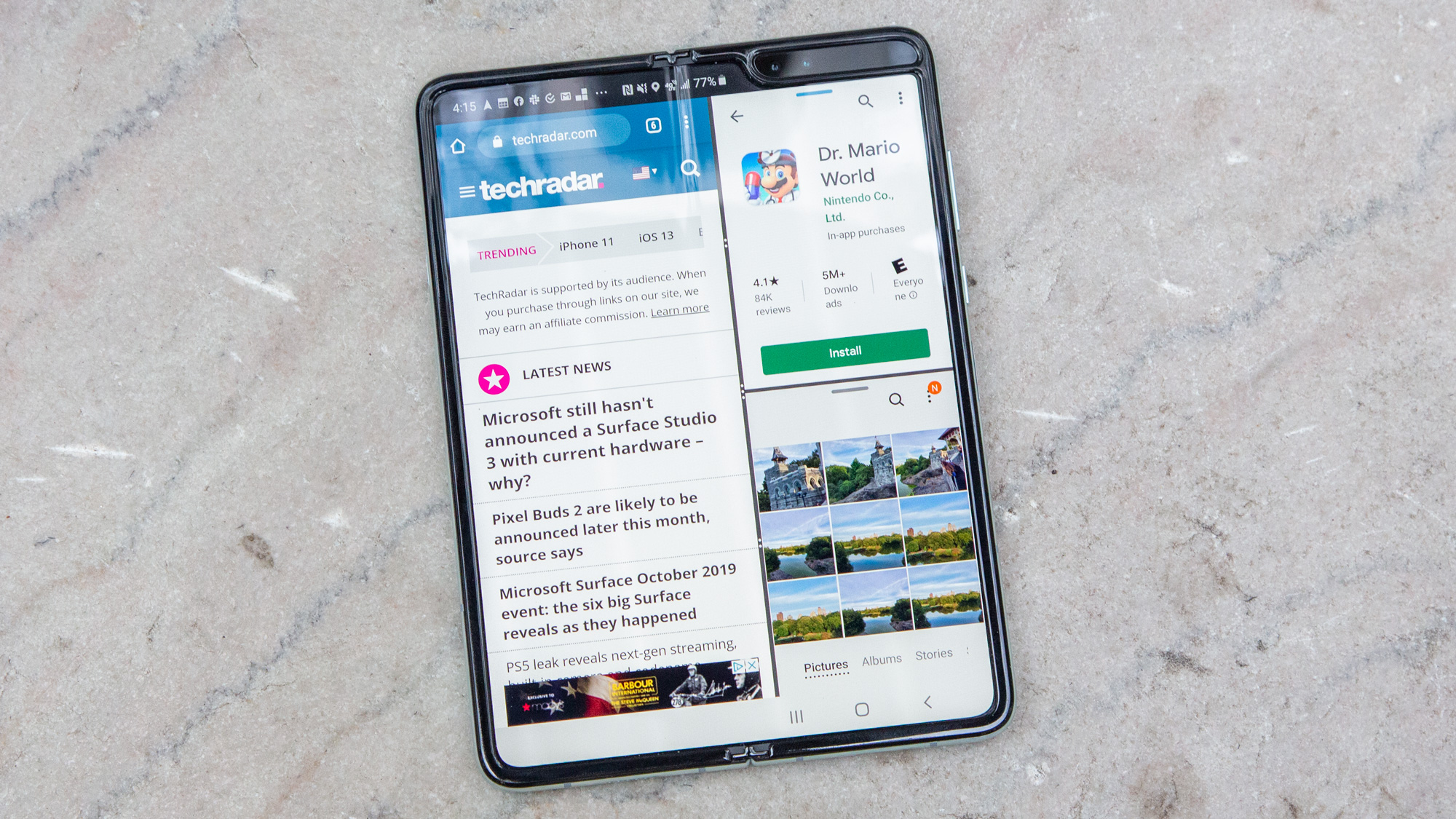
(Image credit: Future)
Interface
- App Continuity allows you to easily transition between screens
- Multi-Active Window allows you to have 3 apps open at once
Samsung's fold hardware is only half of the story. Its software was made reactive to the transition from the small phone screen to the larger tablet screen, and it does that fairly well with a feature called App Continuity.
Apps Continuity allowed us to browse Chrome, Yelp reviews, and Google Maps while walking with the phone folded, and then seamlessly open up to those same apps on the larger screen when we came to a standstill (usually lost in the wilds of Central Park and needing finer directions in Google Maps).
The reverse – keeping apps open when you fold the phone – is also possible, but we had to tick off each app in a display settings submenu. Apps we enabled to go from big screen to small screen included Messages, Slack, Chrome and Google Maps – things we'd want to keep using upon exiting a subway in folded mode. Otherwise, Cover Display ends things and shows the always-on screen (time, date, battery life).
Samsung's says "the possibilities are endless with Multi-Active Window". That's true if "endless" is defined by up to three active apps open at once. It's cramped for sure, but we had a Google Sheet open in the biggest window, a Hangouts call going in a smaller box, and Slack in the tiniest windows to at least see the latest message from our TechRadar team.
Sadly, not all apps, including Hangouts Meet, work in Multi-Active Window mode, and creating App Pairs is strangely not a thing on the Samsung Galaxy Fold – yet.
While the 4.6-inch display has a traditional smartphone aspect ratio which plays nicely with apps, the square, foldable 7.3-inch screen of the Galaxy Fold means apps can look a little awkward on it.
Developers are able to code apps to fit the 4:3 aspect ratio nicely, with the likes of Clash Royale and PlayerUnknown's Battlegrounds filling the space nicely without any stretch or pixelated elements.
However, there are some apps and games which don't take to the aspect ratio quite as well. While Pokemon Go displayed as expected when viewing the map and catching Pokemon, the menus appear 'zoomed in', resulting in less information displayed on screen at a time, more scrolling required and a slight down tick in graphical sharpness.
It's still perfectly playable, but the menus are a little frustrating. It's down to the developer to address this - and it can do with an app update - but there's no guarantee it'll put the work in to support just one handset.
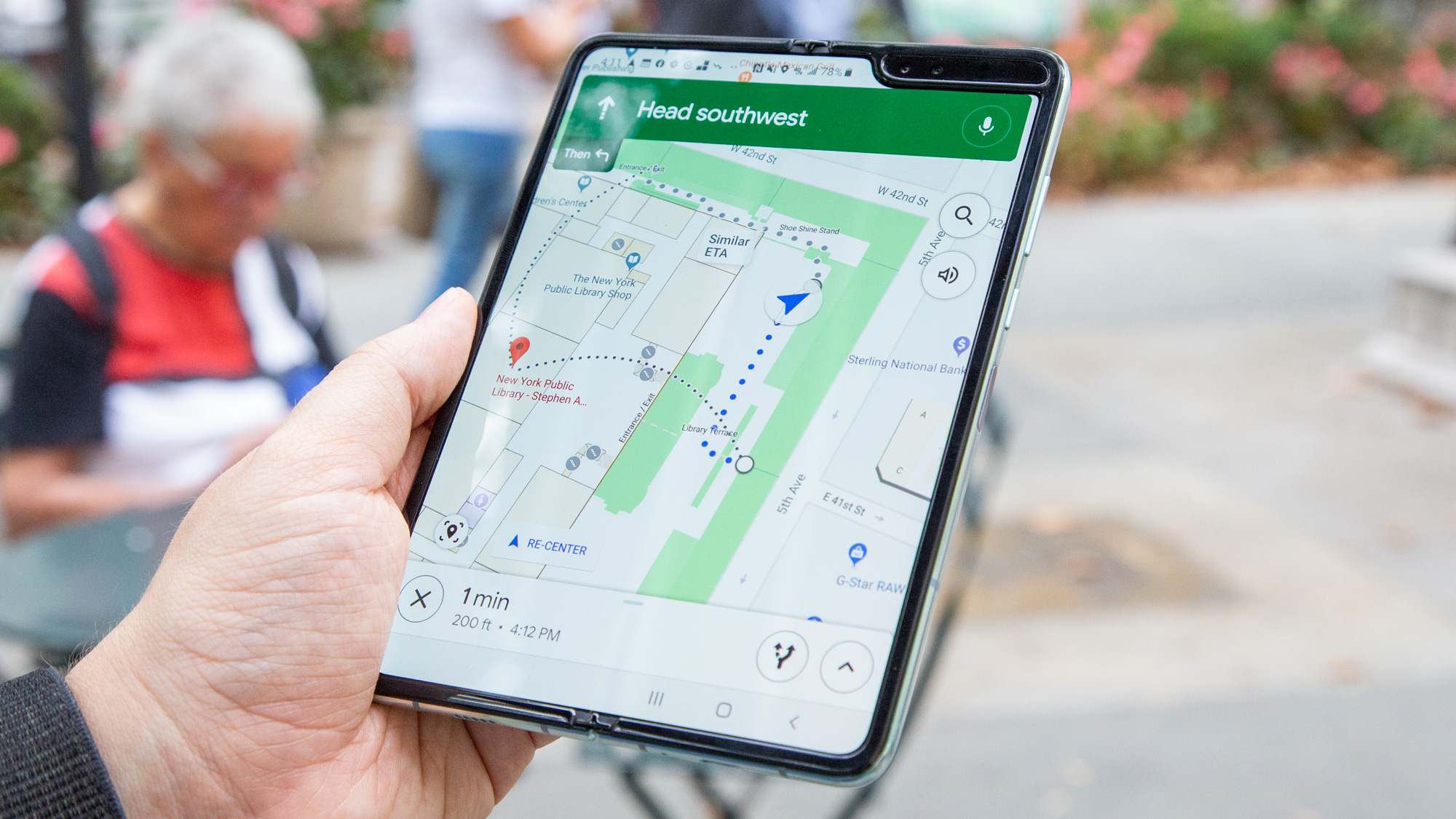
(Image credit: Future)
Performance
- As fast as the Galaxy Note 10, but the iPhone 11 series is still faster
- 12GB of RAM does even out having three apps open at once
- 512GB of internal storage, but no microSD slot for any more space
Samsung Galaxy Fold isn't going to outpace the performance of current phones, as if this were a specced-out gaming desktop at an absurd price. You're paying for the screen innovation, not the latest chipset. That said, it matches the Galaxy S10 and Note 10 performance numbers thanks to its use of the Snapdragon 855 chipset.
Yes, Samsung could have opted to include the higher-end Snapdragon 855 Plus, but it stuck with the configuration announced in April. More importantly, it has 12GB of RAM that gives it a high yield when multiple apps are open.
It earned a multi-core score of 2,598, according to our Geekbench 5 benchmarking tests, with only the iPhone 11 Pro earning noticeably better marks (3,420). Without any noticeable lag, your foldable phone should be good to last – internally at least.
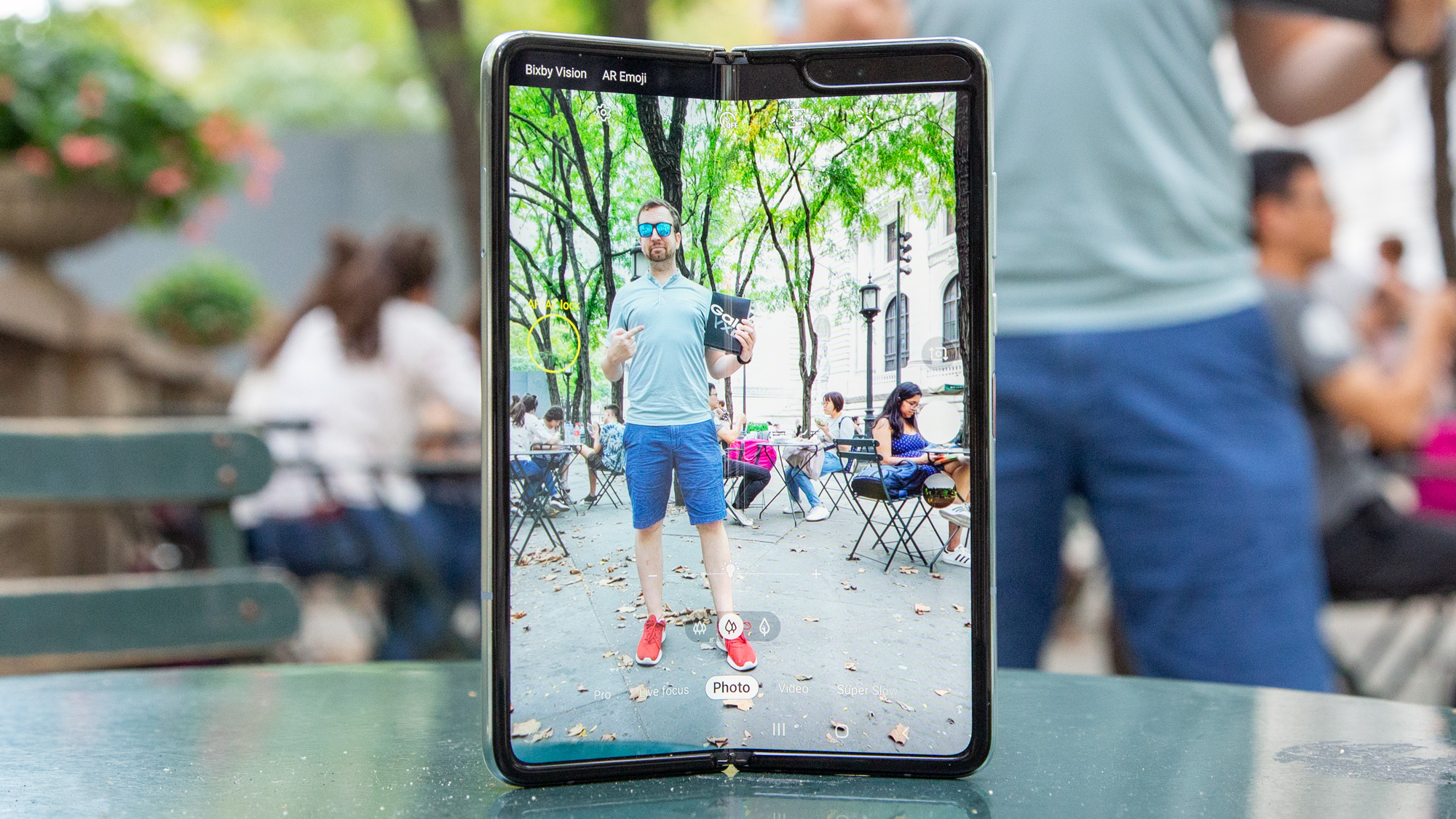
The Fold can act as an makeshift tripod when half bent (Image credit: Future)
Cameras
- 1 Cover Display camera, 2 inner front cameras, 3 rear cameras
- Overall quality is very similar to the Galaxy S10 Plus
- Great photos with fun filters, although not 'the best cameras'
There are six Samsung Galaxy Fold cameras, and they're all technically the same as the five S10 Plus and four Note 10 cameras. Let us explain and show you the mix.
The Cover Display has a single 10MP selfie camera with a f2.2 aperture, a pixel size of 1.22 microns, and a field of view of 80 degrees. It's the same configuration as the Note 10 front camera, only it can't shoot Live Focus video, the Live Focus photos are just okay, and we've mostly used it for unlocking the phone when device is closed.
When unfolded, the dual front cameras on the inside consist of the same 10MP selfie camera and an 8MP RGB camera (f1.9, 1.12 microns, and 85 degree FoV). The latter is meant for depth-sensing and comes from the S10 Plus dual camera hole-punch (the S10 Plus version is only a hair wider with a 90 degree FoV). We used this for Live Focus selfies with fun filters like the selective black-and-white Color Point mode.
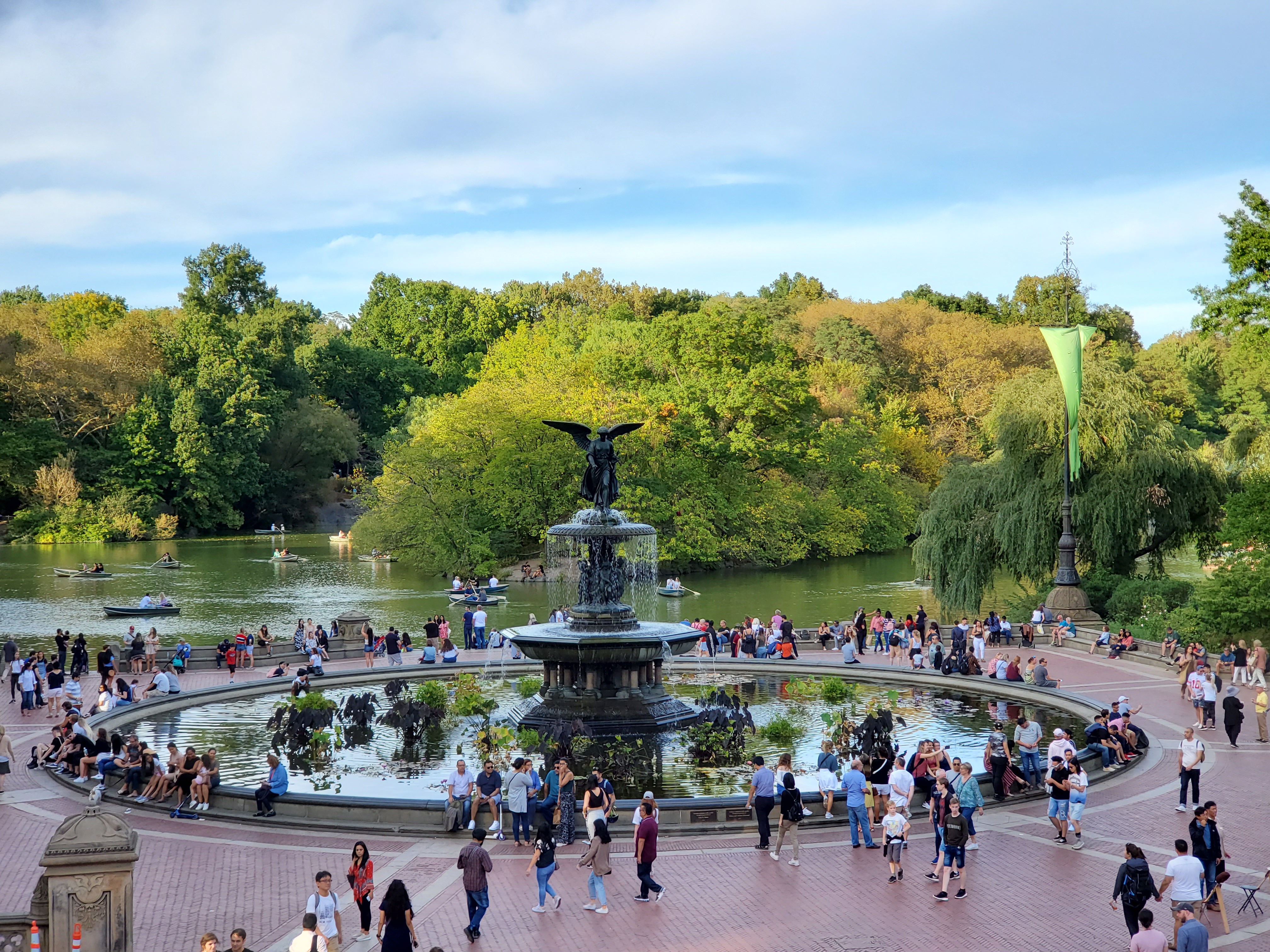
(Image credit: Future)
Galaxy Fold telephoto camera lens
On the back of the Fold, the three rear cameras come straight from the S10 Plus: a 12MP regular camera (f/1.5 + f/2.4, 1.4 microns, 77 degree FoV), a 12MP telephoto camera (f2.4, 1 micron, 45 degree FoV), and the ultra-wide camera (f/2.2, 1 micron, 123 degree FoV).
Samsung has the best ultra-wide camera, even with the iPhone 11 series getting a very similar 120-degree camera. Sadly, the Fold misses the upgrades that came in the Note 10 and Note 10 Plus: a slightly better f/2.2 telephoto lens, Live Focus video (it's okay, that mode wasn't great), and new Live Focus photo filter Big Circles.
You're going to be impressed no matter what with these cameras. The app is robust, yet easy-to-use, and launching it is still a cinch – just double press the power button. Side-by-side photo comparisons show some odd coloring and Night Mode isn't as bright as in the iPhone 11 Pro, but no one is doing ultra-wides as well nor have filters as good as Color Point, and that makes Samsung's cameras the most fun to use.
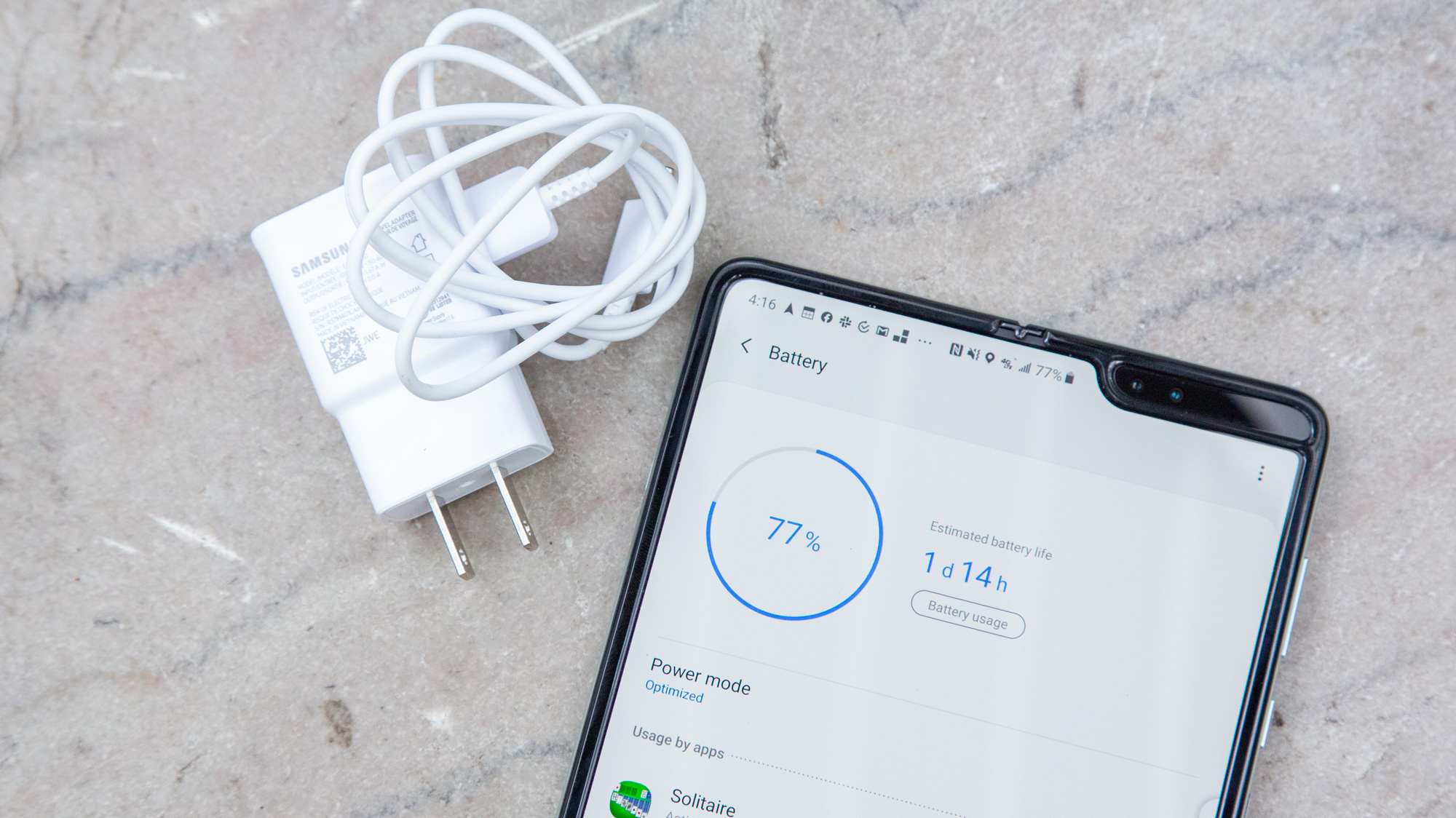
(Image credit: Future)
Battery
- Two batteries combining for a super-sized 4,380mah capacity
- We averaged a day-and-a-half on average, but varied wildly
- Not Super Fast Charging compatible like the Note 10 series
Rule of thumb: the bigger the smartphone, the larger the battery capacity. That rule also comes with a caveat: the bigger the screen, the more battery life the phone requires.
Samsung’s 4,380mah battery capacity is its largest and so is the 7.3-inch display. The combination of big battery and big screen averaged out to a day-and-a-half of battery life with steady use in our tests. We had the main display open two-thirds of the time, and the Cover Display active one third of the time when we actively used the phone.
Subsequent testing proved that we could deplete the battery in a single day by gaming a bunch, binge-watching videos, and running multiple apps at once – basically running screen-on time to the max, the way a power user would on a long-haul flight.
Fold battery life varies wildly based on which of the two screens you use and for how long. You might come away with more battery life from the Samsung Galaxy Note 10 Plus, which consistently lasted us a slightly more than a day-and-half in our tests.
Samsung’s Super Fast Charging is the one thing we’re missing, and that’s important for a phone with such a big battery. It comes with a Galaxy S10-era 15W charger, but the 25W charger included with the Note 10 series and the optional 45W charger aren’t just absent - they aren’t even compatible, and won’t benefit this massive phone.
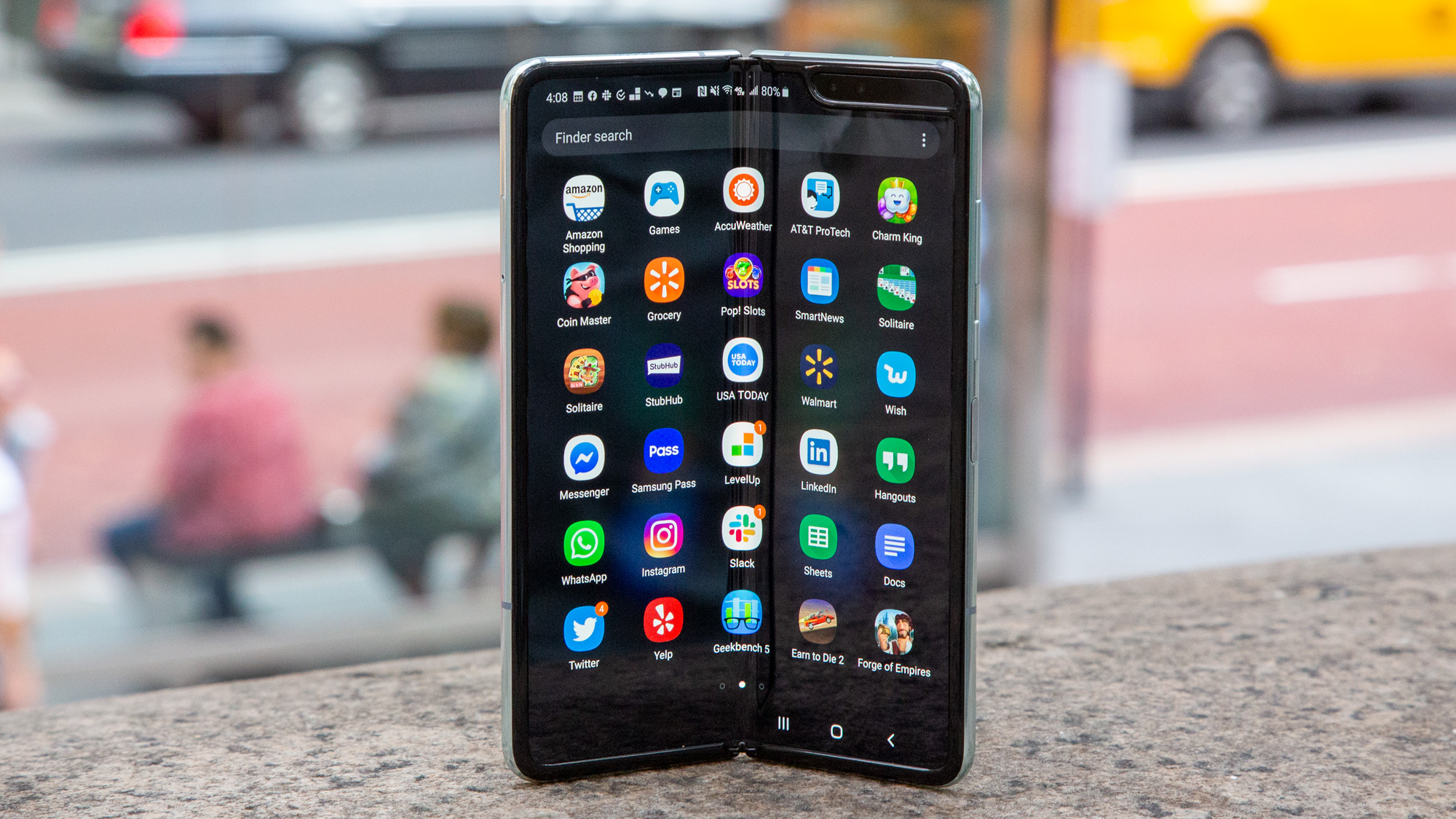
(Image credit: Future)
Buy it if...
You want to impress the world with your phone You can be a show off, too! We love talking technology and there was no better conversation starter than the Fold. The bendable screen provides a ‘wow’ factor like no other phone.
You want to game on a great big screen We’re more convinced than ever that mobile games will be the killer app for foldables. Going back to an iPhone afterward felt like we were playing games on a candybar-style feature phone.
Don't buy it if...
You can wait for the next foldable phone We’re not even going to tell you ‘don’t buy this because it’s expensive’. That’s obvious. Even if you have the money, waiting until 2020 for an inevitable sequel is like a more logical choice.
You just know you’ll break this thing Our Fold has survived, but anything could’ve taken it down – more than the usual suspects like keys, water, and sand, too. We’re talking about credit cards or coins lodged in the middle of the folded screen or even excessive pressure.
- Check out our Samsung promo codes for the best Samsung offers and discounts.
